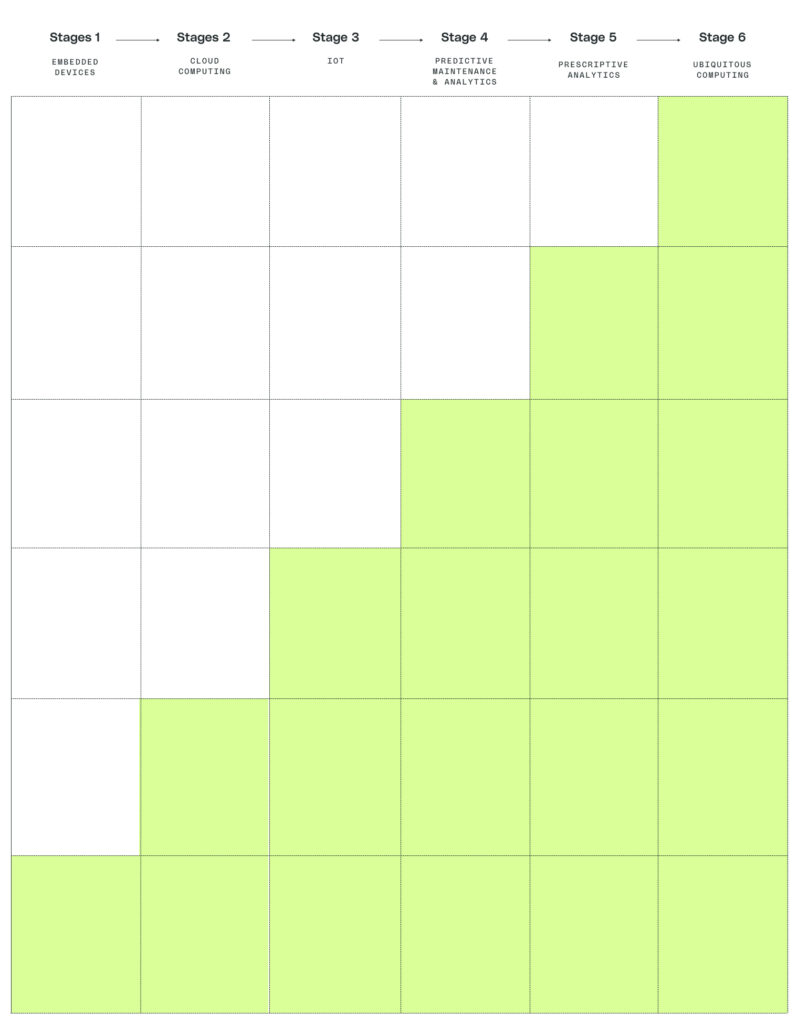BLOG
IoT Strategy: Introducing the IoT Maturity Model


Developing a successful IoT product takes more than hardware engineering, writing code, or even an innovative idea.
If you want your product to remain profitable and relevant in the long term, you’ll need to get strategic about your decisions — and not just the fun ones like which features to include during product design, or which demographics to target.
From a business standpoint, you’ll need a plan that:
- Puts your product into context within the larger IoT marketplace.
- Considers every angle involved in developing a successful product.
We know this is a lot to manage. That’s why we developed the IoT Maturity Model—to help organizations understand what it takes to build an IoT solution that fuels long-term revenue growth.
Read on to learn about the IoT Maturity Model and how embracing it as a framework sets the stage for long-term profitability.
The 6 Stages of the IoT Maturity Model
Developing an IoT product gets exponentially harder as the process continues.
Because IoT projects span multiple disciplines, skill gaps typically increase as system complexity increases.
And let’s be honest: No single person can achieve the level of mastery needed for every discipline required to deliver functional, secure, scalable solutions at every stage.
To explore what it takes to climb the rungs of IoT maturity, we’ll look at how music services play out at different levels of the model.

Stage 1: Embedded Devices
At stage one, embedded devices refer to any device with circuitry that fulfills a specific purpose. In keeping with our music theme, examples include cassette players, Walkmans, and iPods. These standalone devices play music and that’s about it.
Stage 2: Cloud Computing
Cloud computing devices interface with a centralized point over the internet (usually a server). Popular services include Pandora and Spotify, especially in their early years before the Machine Learning (ML) explosion that gave rise to recommendation engines.
To qualify as a stage two product, one device must talk to another device. In our music streaming services example, our computers or phones “talk” to the service provider’s cloud-connected machines.
Stage 3: IoT Connectivity
Next, we climb up to stage three: IoT connectivity. This is the stage where a device truly becomes an IoT product.
In the music world, Sonos is a prime example. Not only do these smart speakers connect to each other to optimize acoustics and create a richer listening experience, but they also integrate with a variety of other systems.
In addition to allowing users to control their speakers with a smartphone, the Sonos app connects with:
- Apple iPhones/Macbooks: With Airplay, Apple users can play music on their Sonos speakers from an iPhone or Macbook laptop.
- Spotify Connect: This feature syncs your current listening sessions to the cloud so that you can use any device to control exactly where and how your music plays.
- Amazon Alexa and Google Assistant: Connecting with voice assistants lends additional functionality to the app that supports a range of use cases.
- Various other devices: From televisions to vinyl record players, these speakers can also connect to various other devices throughout your home.
At stage three, we’re dealing with a comprehensive IoT ecosystem. By linking these interconnected devices together, we begin to see the true promise of IoT — but we’re still far from the end of our journey.
Stage 4: Predictive Analytics
The predictive analytics stage is where we can start thinking less about the device’s baseline technical aspects and more about the data it collects, and what we can learn from it.
This is also where machine learning comes into play: first, our devices collect the data, then our data scientists get to work aggregating, cleaning, and feeding it to ML models.
The goal is to identify patterns in the data to determine future performance — or whether those patterns are likely to re-emerge. We commonly see predictive analytics at play in the Industrial Internet of Things (IIoT) where it’s used for predictive maintenance.
For instance, we’ll feed sensor data from a factory machine into an ML algorithm and the output tells us how likely that machine is to break (or when we can expect a malfunction), enabling us to repair it beforehand to minimize downtime.
In terms of music, there are a few ways this can play out. One is the familiar recommendation engine. If we’re big fans of one genre or artist, a streaming service can look at the listening habits of other users who share our tastes and then recommend new music.
Another possibility is a smart speaker that can tell if we’ve rearranged the furniture in the room and can recommend a new placement for the speaker to optimize the room’s acoustics.
A third option is a speaker that recognizes when its sound quality degrades and can recommend picking up a new one.
Stage 5: Prescriptive Analytics
Things start to get really interesting at stage five where products leverage prescriptive analytics.
Arguably the most cutting-edge business model, you’ll only see prescriptive analytics in the most technologically advanced products. Accordingly, these stage five products are also the most consistent in generating high revenue streams.
Though this stage shares some similarities with the predictive models of stage four in that it uses current and historical data for ML modeling, the main advantage of prescriptive analytics is that it recommends which future course to take.
This is the stage where we answer the question, “How do we make the user experience (UX) better with the data we’re collecting?”
For instance, let’s say a married couple listens to music every night while cooking dinner, and they typically tell their smart speaker to put music on when entering the kitchen.
If we introduced prescriptive analytics into this equation, then an algorithm could look at both of their calendars, figure out when their last meetings are, and ask if they wanted to listen to music — all before either person issues a command.
Prescriptive analytics can take this a step further by figuring out what kind of music users like based on mood. With biometrics from someone’s Fitbit, for example, a smart speaker with prescriptive analytics could detect a spike in their blood pressure and play some chill beats to promote relaxation.
Given the insights that come along with collecting and acting on user data, the profit potential of stage five IoT products is high. When you can recommend new products and services to users based on what’s known, your offers are more likely to feel like an intuitive fit — because they are.
But the goal here isn’t just to pry people’s wallets open. Our mission for stage five products is to provide a tangible benefit that makes their lives easier or more convenient.
Stage 6: Ubiquitous Computing
The pinnacle of the IoT maturity model is stage six: ubiquitous computing.
In this paradigm, IoT devices are completely interconnected, constantly available, and downright pervasive. Elon Musk’s moonshot technologies certainly fit the bill: self-driving Teslas, worldwide internet beamed down from the Starlink, and, of course, a literal computer chip embedded into one’s skull, the Neuralink.
While no company or society has managed to turn this science fiction into reality, we’re getting there. This is especially true in China, where investments in smart cities, advanced artificial intelligence systems, and a unified data landscape on all-in-one platforms like WeChat remain high.
This doesn’t mean that American companies like Amazon, Google, and the aforementioned Musk-eteers aren’t making great progress towards bringing the benefits of ubiquitous computing to the west.
A music service in a world of ubiquitous computing would quite literally be a soundtrack to your life. Putting on your jogging shorts? Cue the motivational jams. Getting ready for bed? Turn down the volume and play something relaxing.
Besides these automatic transitions, we’d also be able to seamlessly control the music with voice commands, or perhaps even a good old-fashioned remote control on occasion.
Now that’s a mature IoT product.
Assessing Your Product’s IoT Maturity
Now here’s the big question — how do you get your product to reach maturity? What technical challenges crop up along the way, and what do you need to do to surpass them?
The answers were beyond the scope of this article, so we outlined the technological hurdles you’ll need to clear to advance from one stage to the next in a separate post.








